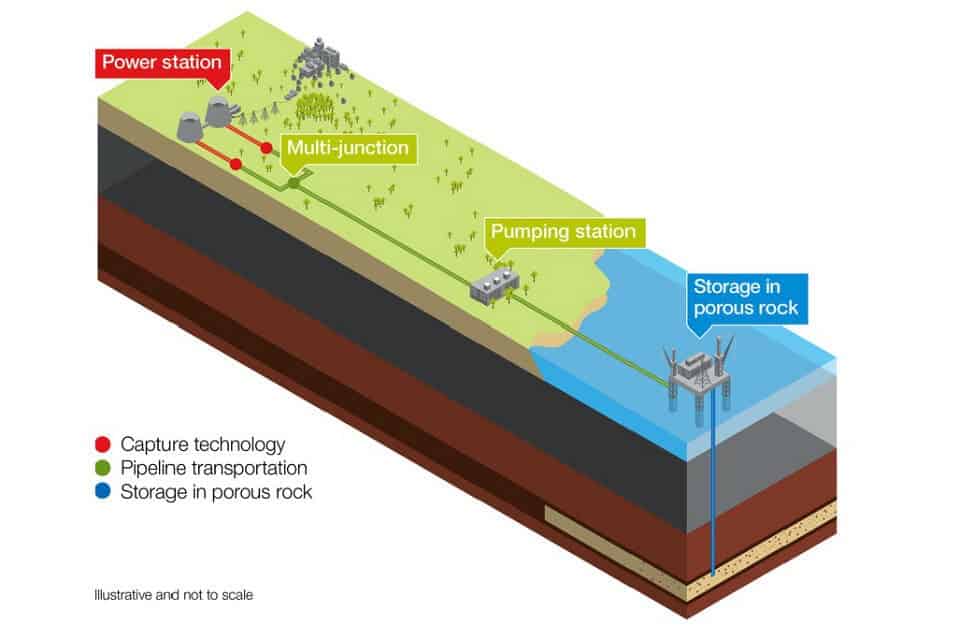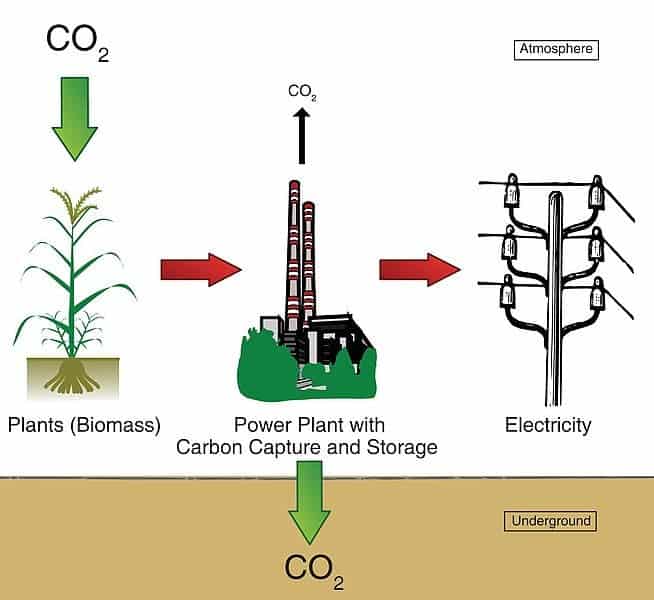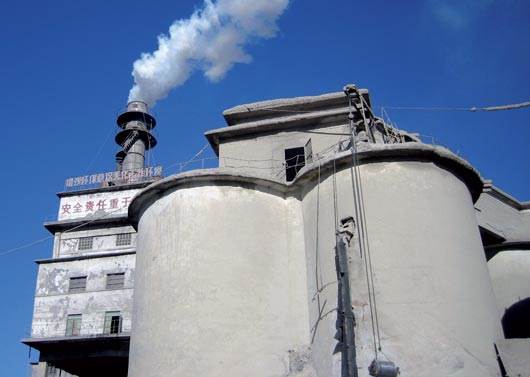Carbon Capture and Storage (CCS) is the process of capturing carbon dioxide (CO2), a greenhouse gas, and depositing it somewhere it will not reach the atmosphere again — typically in a suitable geological formation. The goal is to reduce the amount of greenhouse gases in the atmosphere and limit (or even reverse) man-made climate heating.
Does it work?
It’s not science fiction. The technology already exists and several projects are already underway. The carbon dioxide is typically extracted from a single point source (like a cement factory or a fossil fuel facility), and injected into a porous structure where the CO2 can be absorbed without leaking back into the atmosphere. Carbon dioxide can also be absorbed from the air, although the efficacy of this process is much lower.
Carbon capture and storage can reduce the emissions of a plant by up to 90% and when coupled with other technologies, CCS can even lead to negative emissions.
The technology is regarded by many researchers as a key tool in our fight against global warming and greenhouse gas emissions as it is not only a way to reduce our emissions, but maybe even to grab some of the greenhouse gases already present in the atmosphere and store them. However, CCS comes in many different forms and, at this moment, there are only a handful of operating CCS projects in the world.
Simply put, it works — the physics of the process is valid. But whether or not CCS will really be used on a wide scale and help us keep climate change in check is a very different question.

Why CCS
The planet is heating up. Over the past century, the planet’s average surface temperature has risen by about 2 degrees Fahrenheit (a bit over 1 degree Celsius) — a change driven largely by increased carbon dioxide and other man-made emissions into the atmosphere.
We won’t get into the details of how we know climate change is happening and that it’s caused by mankind. All the available figures and scientific evidence point in this direction. Greenhouse gas emissions have increased steadily since 1890, and as a result, temperatures are rising. The problem is very real and burying our head in the sand won’t help one bit.
If we want to truly manage this crisis, we need to reduce our emissions, achieve net zero emissions, and, ultimately, find ways to revert previous emissions. The good news is that CCS can help with both.
Right now, society most focused on producing renewable energy to replace polluting and carbon-intensive fossil fuels. In truth, it’s not just just the environmental aspect of it, renewable energy is already cheaper in many parts of the world (but that’s a different story). Important as this may be, it’s not enough on its own.
A substantial part of our emissions comes from other industrial activities (like cement factories, for instance) which are extremely hard to decarbonize, and it’s not like all fossil fuel power plants will disappear overnight — we need to reduce emissions from them in the meantime. This is where CCS can come in and make a difference.
However, we can’t just capture carbon dioxide, put it in a box and wash our hands, it just doesn’t work that way. You can’t build a carbon storage factory. Luckily enough though, nature has done that herself.
Geology to the rescue

Some subsurface geological features are excellently suited as carbon storage sites. Some brine-filled pores in sandstone formations, or other similar structures sealed by a natural and impermeable caprock such as a shale or clay. Essentially, you need a porous rock to inject the carbon in, and impermeable rocks to act as a seal around it.
In some contexts, carbon storage has been used for several decades (most notably for enhanced oil recovery), but as a tool to tackle global heating, it’s a relatively new concept. For many current CCS projects, the technology used to lock CO₂ deep underground is the same technology used to enhance oil reservoirs. In one oil field (called Sleipnir), some 23 million tons of CO₂ have been injected underground. In the case of Sleipnir, the positive effect of injecting CO₂ is counterbalanced by the extraction (and subsequent burning) of oil. But what if we could just have the positive effect and not do the oil part? That’s pretty much how the idea of carbon storage emerged.
It’s been actively researched in the US since 1997, but the technology first took off in Norway in the 1980s. Although the basic principle is still the same, CCS as a field of science has grown and developed massively since. CCS publications and studies have increased exponentially in the past 20 years, with international collaboration spurring multiple projects. Still, as of 2019, there are only 17 operating CCS projects in the world, capturing 31.5Mt of CO₂ per year, of which just 3.7 is stored geologically. Compare that to the 5.1 billion metric tons of energy-related carbon dioxide the US emitted in 2019 alone — it takes the US just a couple of days to emit more CO₂than is stored year-round in the entire world.
But this doesn’t mean that CCS can’t grow. The latest IPCC Assessment Report on Mitigation mentioned CCS 35 times in the summary for policymakers. The International Energy Agency has repeatedly said CCS is a key technology for mitigating climate change. More and more, researchers are looking at CCS as one of the key ways to address some parts of our greenhouse gas emissions.
At the very least, the geological potential is there. The US National Energy Technology Laboratory (NETL) reported that North America has enough storage capacity for more than 900 years worth of carbon dioxide at current production rates. Even though there is some uncertainty regarding potential long-term leaking, there’s still more than enough room for the world to dump its carbon underground.
Location, location, location (and technology)
Carbon capture and storage is most effective when it’s applied at point sources such as a single factory or a single storage site — it’s far less effective when dealing with multiple, smaller sources. This is what makes it an excellent technology for heavy-emission industries.

There are three main types of carbon capture and storage for industrial facilities:
- post-combustion capture is the most widely used form of carbon capture and storage. It essentially refers to capturing CO₂ from a flue gas generated after combusting a carbon-based fuel, such as coal or natural gas. A number of different techniques are used ,and post-combustion capture is especially interesting for researchers because existing fossil fuel power plants can be retrofitted to include CCS technology in this configuration.
- pre-combustion capture is widely applied in fertilizers, gaseous fuel (H2, CH4), and power production. The advantage is you also obtain hydrogen which can be used as a fuel. However, retrofitting plants to accommodate pre-combustion capture is challenging and this is mostly an option for new plants.
- oxy-fuel combustion, where the fuel is burned in oxygen instead of air. This results in a flue gas that is mainly CO₂ and water.
There are multiple technologies for separating CO2, becoming more and more efficient every year. But after it’s separated, the CO2 must be transported. This is most easily done via pipes (and has been done before). For instance, there were approximately 5,800 km of CO2 pipelines in the United States in 2008, and a 160 km pipeline in Norway used for enhanced oil recovery.
After it’s separated and transported, it is injected into a suitable geological reservoir.
Negative emissions — taking carbon from the atmosphere
So far, we’ve mostly focused on using CCS for factories, as a way to reduce emissions. But CCS can also be used as a way to revert emissions — or, as researchers put it, to produce negative emissions.

The underlying principle is straightforward: you extract carbon from sources in the Earth’s biological cycle and inject them on the ground. This way, you’re not just reducing the carbon you’re outputting, you’re essentially eliminating some of the already existing carbon. So you would take something like wood chips or biological waste such as manure and inject the carbon from it to a geological storage site.
But it can get even more interesting than that. In a recent study, researchers discovered a way to pull carbon dioxide from the atmosphere and turn it back into coal. This approach is actively being researched by fossil fuel companies, who are looking for a way to maximize returns. However, in order for this to truly have a net positive effect, the subsequent burning of the resulting coal would also have to be captured.
Perhaps the most exciting development comes from Iceland, where researchers found a way to extract CO2 and mineralize it into rocks. They’ve essentially created ‘negative emissions plant’ — a plant that turns ambient CO2 into stone switches.

The key to rapid mineralization of carbon is basalt – a volcanic rock which Iceland has an abundance of. Iceland is actually mostly made up of basalt (90%), and within basalt, CO2 can quickly mineralize (morph into carbonate rocks). “The potential of scaling-up our technology in combination with CO2 storage, is enormous,” said Christoph Gebald, the founder and CEO of Climeworks, the company behind the technology.
But for all these exciting developments, there’s one part we’ve purposely left out until now: money.
Without a carbon tax, CCS just won’t work
What about the money? As we’ve seen in the case of renewable energy, green technologies can only truly succeed when they have at least some economic advantage. Separating CO₂ from other chemicals is costly and also requires energy. But unlike renewable energy, in the case of CCS, there’s no real economic advantage — all you have is a method of reducing CO₂ emissions, that’s it.
At the moment, even as CCS is making great strides in terms of technology and research, the funding for said technologies is starting to shrink. This is a problem not just for carbon storage, but for our ability to meet current climate commitments and avoid catastrophic environmental and economic damage.
Nowadays, CCS projects rely on government incentives and standards — even though economists generally agree that these programs are less effective and more costly than a carbon price. Carbon pricing is notoriously unpopular and hotly debated, but increasingly, leading economists are calling for some sort of a climate tax. Without such a tax (or some pricing mechanism), CCS remains a niche technology and is unlikely to scale massively into the future.
“I prefer to have an economy-wide carbon price to create markets for low-carbon technology. Then markets, not advocates, will make decisions about the technology mix. I believe deployment of CCS would be significant under such a policy,” writes Howard J. Herzog Senior Research Engineer, Massachusetts Institute of Technology.
Simply put, new policies are dearly needed to incentivize commercial CCS. No matter how you look at things reaching net-zero emissions (and maybe, someday even negative emissions) seems much harder without CCS — but without financial incentives CCS cannot flourish, even when the technology matures. A University of Warwick report concludes:
“CCS has considerable potential to reduce CO2 emissions not only by a significant amount but also at a social cost that most economists would not consider prohibitive, particularly in comparison to the social costs predicted for a business-as-usual scenario with unregulated carbon emissions.”






